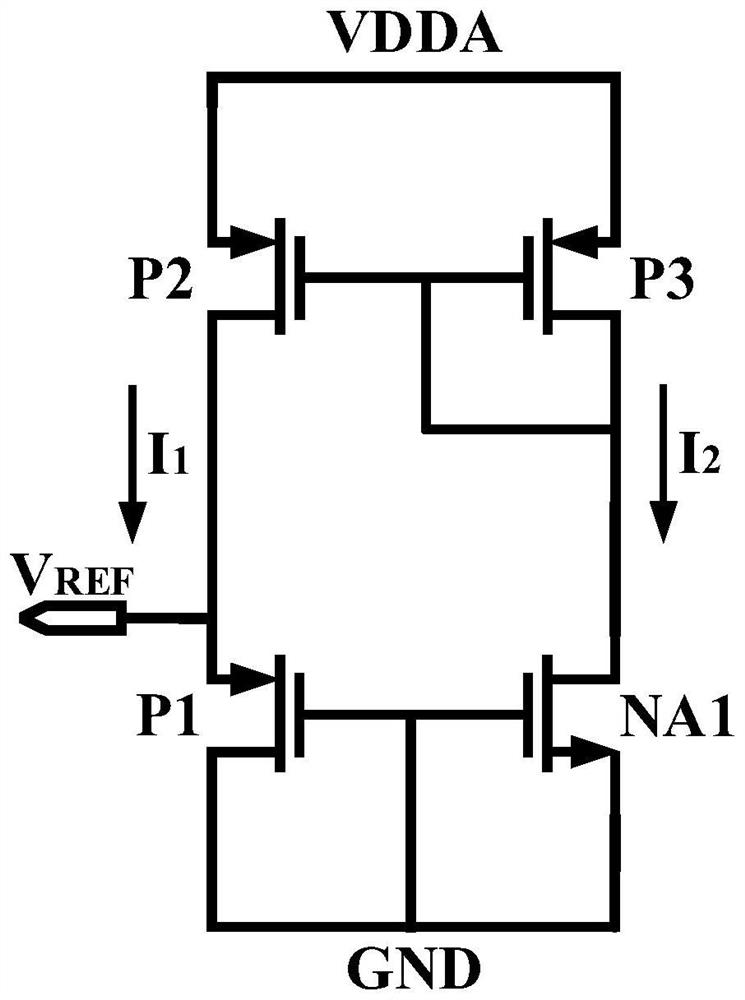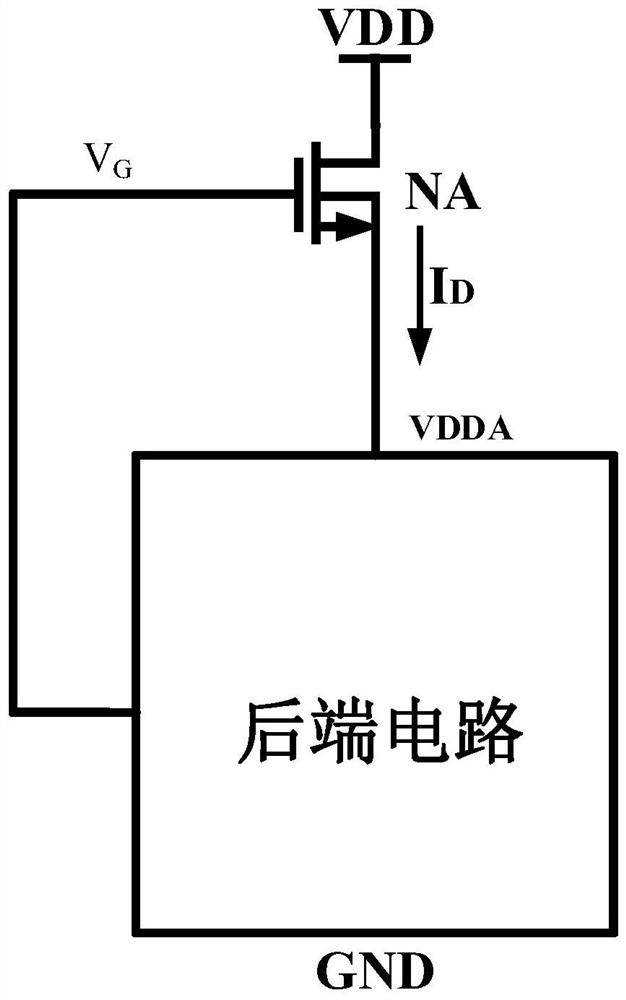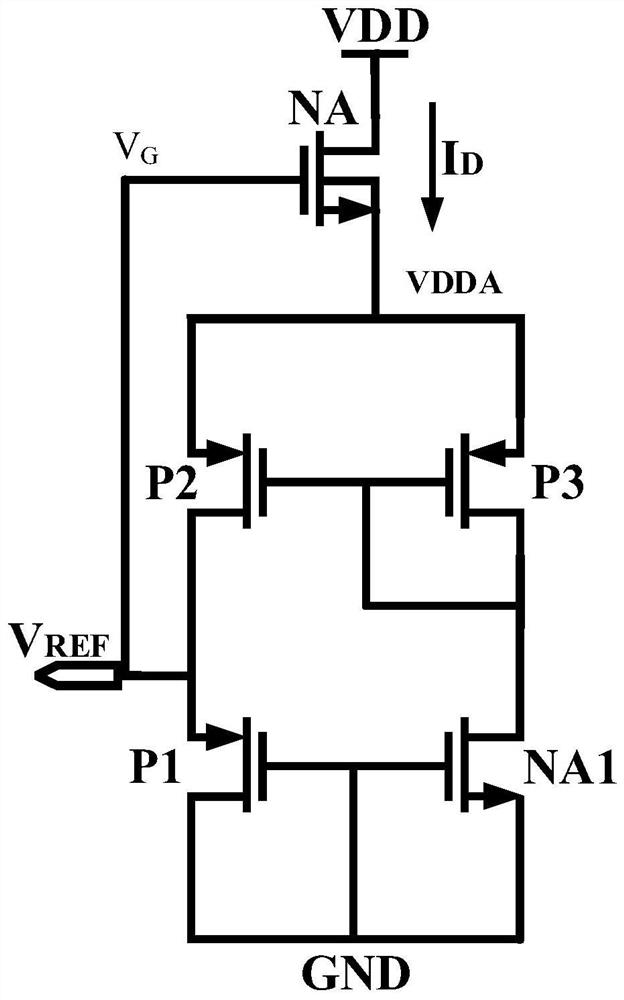Zero-current-loss single-tube grid-control circuit with pre-voltage-stabilization function
A pre-regulated, zero-current technology, applied in the direction of regulating electrical variables, control/regulating systems, instruments, etc., can solve the problems of increasing chip area, increasing design difficulty, and large current loss, and achieves miniaturization of chip area and good pre-conditioning. Voltage stabilization effect, circuit minimization effect
- Summary
- Abstract
- Description
- Claims
- Application Information
AI Technical Summary
Problems solved by technology
Method used
Image
Examples
Embodiment 1
[0037] A pre-regulated zero-current loss single-tube gate control circuit comprises: a back-end circuit and a MOSFET device electrically connected with the back-end circuit. The threshold voltage of the MOSFET device is zero limit or the MOSFET device is depletion mode. The gate voltage control of the MOSFET device is used for pre-regulation to provide a pre-regulation potential for the back-end circuit. where the zero limit is a positive or negative value equal to or close to 0. The back-end circuit is the part of the circuit that requires pre-regulated power supply.
[0038] In this embodiment, only one MOSFET device or depletion-mode MOSFET device with a threshold voltage of zero limit can be used to realize pre-regulation, and the positive gate voltage control and the back-gate voltage control are respectively used to realize pre-regulation. The pre-regulation part No additional current branch is introduced, and the current consumed on it is the inherent current loss of ...
Embodiment 2
[0040] On the basis of the first embodiment, the MOSFET device is an N-type MOSFET device (NMOS device). Among them, for an N-type MOSFET device, the threshold voltage is zero limit value, that is, the threshold voltage is a positive value equal to 0 or close to 0, or the MOSFET device is a depletion-type N-type MOSFET device with a negative threshold voltage. .
[0041] Using the gate voltage control of the MOSFET device to perform pre-regulation to provide a pre-regulated potential for the back-end circuit, including: using the gate voltage control of the MOSFET device to pre-regulate the power supply voltage to provide a pre-regulated input potential for the back-end circuit. In this embodiment, the N-type MOSFET device can be controlled by a positive gate voltage and a back gate (substrate) voltage, respectively.
[0042] Among them, single-transistor positive gate control pre-regulation refers to: using a single N-type MOSFET device with a threshold voltage equal to 0 or...
Embodiment 3
[0069] On the basis of the first embodiment, the MOSFET device is a P-type MOSFET device (PMOS device). The threshold voltage of a P-type MOSFET device is zero limit or positive. Among them, for P-type MOSFET devices, the zero limit is 0 or a negative value close to 0, that is, a P-type Native MOSFET device with a threshold voltage of 0 or a negative value close to zero, or a power consumption with a positive threshold voltage. Exhaust-type PMOS devices are used as P-type MOSFET devices. Using the gate voltage control of the MOSFET device to perform pre-regulation to provide a pre-regulated potential for the back-end circuit, including: using the gate voltage control of the MOSFET device to pre-regulate the ground potential to provide the back-end circuit with a pre-regulated ground potential.
[0070] The realization of pre-regulation is described in detail below with depletion-mode PMOS devices: the back-end circuit is the part of the circuit that needs pre-regulated power ...
PUM
 Login to View More
Login to View More Abstract
Description
Claims
Application Information
 Login to View More
Login to View More - R&D
- Intellectual Property
- Life Sciences
- Materials
- Tech Scout
- Unparalleled Data Quality
- Higher Quality Content
- 60% Fewer Hallucinations
Browse by: Latest US Patents, China's latest patents, Technical Efficacy Thesaurus, Application Domain, Technology Topic, Popular Technical Reports.
© 2025 PatSnap. All rights reserved.Legal|Privacy policy|Modern Slavery Act Transparency Statement|Sitemap|About US| Contact US: help@patsnap.com



